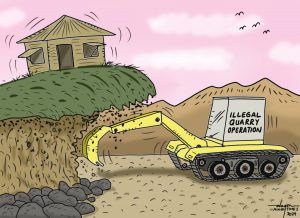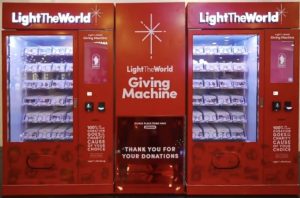monday issue august 10, 2020
BY VIC N. SUMALINOG
When the Corona Virus Disease 19 (CoViD 19) pandemic started extending its deadly rampage in Davao City, among the hardest hit by the infection are barangays along Quezon Blvd. Mayor Inday Sara Duterte-Carpio ordered the concerned areas placed in hard lockdown. We know it was one hard decision for the mayor because the areas are home to a large number of Davaoenos. And many of them are informal settlers especially those having their houses built on the shorelines way beyond the perimeters of the World Bank-funded Slum Improvement and Resettlement (SIR) project. And even if the residents in the barangays concerned own the houses where they reside these are so congested that social distancing health protocol becomes too difficult to observe. What with so tiny roads crisscrossing the communities used by both people and vehicles at the same time! What with alleys so small that doors of houses fronting each other less than two meters apart!
The condition in those barangays has made the areas thereat overly vulnerable to the CoViD pandemic. And it is indeed tragic that what was feared to happen in such vulnerable places did occur. Thus, the mayor took the lockdown measure even if possibly deep in her heart she did not want to do it.
But who knows such tragedy could also be one big opportunity to introduce the development most appropriate for the barangays affected. That is, if the city leadership has the political will and guts to do something that may affect, negatively or positively, the political future of those who are presently at the helm of the local government.
It is a fact that Davao City is the biggest in the world in terms of land area. But it is also equally true that the city’s commercially and industrially developed sectors are limited only to the more urban centers of such Davao townships as the Poblacion, Toril, Sasa-Panacan-Bunawan-Lasang stretch, and of late, the Mintal and Calinan proper.
But even the more developed first political district where the seat of the city government is located, is still wanting for more space to accommodate the influx of business establishments. After all, for a city like Davao, expansion of urbanization does not necessarily mean pushing development immediately to the outskirts of the city proper. And we are looking at Barangays 23-C, 22-C, and 21-C as one big potential for the local government to offer to post pandemic investors in land development where existing residents be given a crack at owning a unit in some kind of low storied condominium type residential buildings at affordable cost. Certainly the scheme will allow them to remain closer to their workplaces or livelihood locations.
Doing this however, requires, first and foremost, political will. Assuming of course that from the areas where the CoViD 19 cases have been prevalent the larger portion remains the property of the city, and that those that have been covered by SIR Project are already fully paid and titled to the beneficiaries.
Davao City can adopt the South Reclamation and North Reclamation Projects in Cebu City and Province as models in developing the blighted barangays along Quezon Blvd. A huge portion of the Cebu City project was also former informal settlers’ colonies. What can be done by the city government of Davao to conduct a resurvey of the place while at the same time revisiting the various documents pertaining to the implementation of the SIR project.
If the city leadership finds enough legal grounds to finally decide to develop the area into a mixed residential- commercial space, then it has to start working on a huge, deliberately planned resettlement communities for the informal residents. The local government can do this in partnership with corporate conglomerates that are interested to invest in developing that area along Quezon Blvd.
The city planners can also look into the inclusion of whatever is left of the vacant space created by a disastrous fire over four years back, as well as by reclaiming the seashore bordering the three affected barangays. The reclaimed portion, the fire-gutted area and the spaces that may be created when non-SIR beneficiaries move to new relocation sites combined can become new city properties that can be sold to prospective locators at premium prices.
Realizing this plan though, will require the city to craft innovative approaches in finding resources to foot the cost of developing the area. And we do not see this as a problem for Davao. We have very good track records for the many loans that the city had contracted in the past to fund projects. We have not, so far, defaulted on our amortizations on several bank loans including the indebtedness that was incurred to build the controversial and abandoned Artica Sports Dome along Diversion Road.
So, it would be easy for the city to look for banks that will extend financial loans to fund the cost of developing the areas. We can even see the possibility of large property developers in the country rushing to make their offers to develop those coastal barangays under the Public Private Partnership (PPP) scheme. Maybe a “build-operate-transfer” or outright equity proposition can be considered ideal. It would now be up to the local government which offer to take, and what scheme to adopt.
As to the planned resettlement communities the city can buy a suitable area, or use what it presently has. Or, it can adopt an “iron-fisted” scheme that may even provide solution to a P1.8 billion problem currently nagging the city: foreclose on huge privately-own tracts of land that are overly delinquent in its real property taxes payment and convert the same into the new relocation site for the residents to be affected by a new development scheme for the Quezon Blvd. barangays mentioned.
To ensure that the new relocation site/s for the affected residents are provided with the needed amenities of a residential enclave, this can be included in the conditions for partnership with the prospective property developers.
Another strategy that the city can adopt is to integrate in its agreement with future business locators to give priority to members of relocated families from the area in their hiring of manpower.
These ideas of ours can be considered “wild” by the so-called “schooled” development planners under the employ of the city government.
But are not wild ideas the beginning of sane solutions to certain problems? What about that gentlemen and ladies of the City of Davao?
Yes, today the city is likely to experience deep financial straits with the disruption of almost all economic activities as a result of the pandemic. But the health emergency, without doubt, will eventually come to an end. And hopefully it will be sooner. When that time comes, Davao City will again be in boom and bloom. Opportunities are forthcoming.



